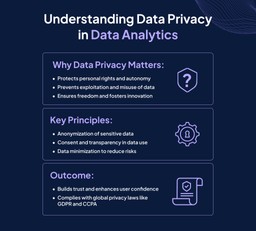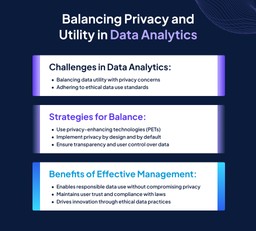Hey there! So, you’ve decided to dive into the fascinating world of data analytics.
It’s an exciting journey, no doubt, filled with insights and discoveries waiting to be unearthed.
But before we delve into the nitty-gritty of analyzing data, let’s talk about something crucial: data privacy and security.
Imagine you’re cruising down the digital highway, sharing your information with a trusted company like General Motors. You assume your data is safe, right?
Well, not always.
Remember the scandal where General Motors was caught selling their clients’ data to insurance companies without their consent?
It was a wake-up call for many, highlighting the critical need to safeguard our personal information.
Now, let’s sprinkle in the excitement of undertaking a data analytics course.
You’ll embark on a thrilling adventure filled with insights and discoveries waiting to be unearthed. But amidst the excitement, it’s essential to remember the importance of protecting the data you’ll be working with.
In this guide, we’ll explore how to ensure data privacy and security in data analytics.
So buckle up because we’re about to embark on a journey to safeguard your data and keep it out of the wrong hands. Ready? Let’s roll!
Why is Data Privacy Important?
Data privacy isn’t just a buzzword; it’s the cornerstone of trust in the digital age. Your personal information is a treasure trove of insights into your life—your habits, preferences, and even vulnerabilities.
Ensuring the privacy of this data isn’t just about protecting your secrets; it’s about safeguarding your autonomy and dignity in an increasingly interconnected world.
Protecting Personal Rights
Your data belongs to you. It’s a reflection of your identity and should be treated with the utmost respect. When companies mishandle or exploit your data without consent, it’s not just a violation of privacy; it’s a breach of trust.
Preventing Exploitation
Data misuse can lead to exploitation. According to Norton, 85% of global adults want to do more to protect their online privacy. This statistic highlights the widespread concern about data privacy and the potential for exploitation when personal information is mishandled.
Preserving Freedom
In today’s digital landscape, data is power. When your personal information falls into the wrong hands, it can be used to influence your decisions, limit your options, or even manipulate your behavior. Protecting data privacy is essential for maintaining individual freedom and autonomy.
Fostering Innovation
Paradoxically, strong data privacy measures can actually fuel innovation. By establishing clear boundaries and consent frameworks, we create a safer environment for data sharing and collaboration.
When individuals feel confident that their data is protected, they’re more likely to participate in research and innovation efforts.
Building Trust
Without trust, businesses struggle to attract and retain customers.
By prioritizing data privacy and preventing data breaches, companies demonstrate their commitment to ethical practices and customer-centric values, ultimately building stronger, more enduring relationships with their audience.
What are the Data Privacy Laws in the US?
Data protection laws in the United States are a patchwork of federal and state regulations that govern the collection, use, and protection of personal information.
While the US lacks a comprehensive federal data privacy law akin to the GDPR in Europe, several federal statutes and state-level regulations provide varying degrees of protection for consumer data. Here are some key laws and regulations:
California Consumer Privacy Act (CCPA)
The CCPA grants California residents certain rights related to their personal information held by businesses.
These rights include the right to know what personal information is collected, the right to opt out of the sale of personal information, and the right to request the deletion of personal information, among others. The CCPA applies to companies that meet specific thresholds for revenue, data processing, or interaction with California residents.
Health Insurance Portability and Accountability Act (HIPAA)
HIPAA establishes national standards for the protection of individuals’ medical records and personal health information.
Covered entities, including healthcare providers, health plans, and healthcare clearinghouses, must comply with HIPAA’s privacy and security rules, which regulate the use and disclosure of protected health information (PHI).
Gramm-Leach-Bliley Act (GLBA)
The GLBA, enacted in 1999, requires financial institutions to safeguard the personal info of their customers. Under the GLBA’s privacy provisions, financial institutions must provide consumers with notices of their privacy practices and let consumers to opt out of certain information-sharing practices.
Is College
Worth It Anymore?
Children’s Online Privacy Protection Act (COPPA)
COPPA, enacted in 1998 and enforced by the Federal Trade Commission (FTC), regulates the online collection of personal info from children under the age of 13.
Covered websites and online services must obtain verifiable parental consent prior to collecting, using, or disclosing personal information from children.
Federal Trade Commission Act (FTC Act)
This Act empowers the Federal Trade Commission to take enforcement action against companies engaged in unfair or deceptive practices regarding consumer privacy and data security.
While not a standalone data privacy law, the FTC Act serves as a broad regulatory framework for protecting consumer interests in the digital marketplace.
The Differences Between Data Security and Data Privacy
Data security and data privacy are often used interchangeably, but they refer to distinct concepts that work together to protect sensitive information.
Understanding the differences is crucial for effectively safeguarding data in the digital age.
Data Security
Data security protects data from unauthorized use, access, disclosure, alteration, or destruction.
It encompasses a range of technical measures, policies, and procedures designed to mitigate risks and vulnerabilities in data storage, transmission, and processing systems. These measures include encryption, access controls, firewalls, intrusion detection systems, and regular security audits.
Example: Implementing encryption protocols to protect data during transmission over networks, ensuring that even if intercepted, the data remains unintelligible to unauthorized parties.
Data Privacy
Data privacy is concerned with the proper handling and management of personal information.
It involves controlling how data is collected, stored, shared, and used, ensuring compliance with relevant privacy laws and regulations, and respecting individual rights and preferences regarding the use of their data.
Data privacy emphasizes transparency, consent, and accountability in the handling of personal information.
Example: Obtaining explicit consent from users before collecting their personal data for marketing purposes and providing them with options to opt out of data sharing.
Relationship Between Data Security and Data Privacy
While data security focuses on safeguarding the confidentiality, integrity, and availability of data, data privacy ensures that individuals have control over their personal information and that it is handled fairly, transparently, and ethically.
Data security measures are instrumental in upholding data privacy principles by preventing unauthorized access or misuse of sensitive information.
Example: A company implements robust encryption (data security measure) to protect customer data stored in its databases, thereby ensuring compliance with data privacy regulations and maintaining customer trust.
In summary, while data security addresses the technical aspects of protecting data from threats and vulnerabilities, data privacy concerns the ethical and legal considerations surrounding collecting, using, and sharing personal information.
Both are crucial components of a comprehensive data protection strategy, working together to safeguard sensitive information and uphold individual rights and freedoms in an increasingly data-driven world.
How Data Privacy and Security Play Their Part in Data Analytics
Data analytics holds immense potential for extracting valuable insights from vast amounts of data. However, this process also raises important considerations regarding data privacy and security.
Let’s explore how these two crucial aspects intersect with the world of data analytics:
Data Privacy in Data Analytics
In the realm of data analytics, privacy concerns arise from the collection, processing, and analysis of personal information. It’s essential to ensure that data analytics initiatives prioritize individual privacy rights and comply with relevant privacy regulations such as GDPR, CCPA, and others.
- Anonymization and Pseudonymization: To protect individual privacy, sensitive data can be anonymized or pseudonymized before analysis. This involves removing or obfuscating personally identifiable information (PII) to prevent the identification of individuals within the dataset.
- Consent and Transparency: Data analytics projects should obtain informed consent from people whose data is being analyzed. Providing clear and transparent information about how data will be used and offering individuals control over their data builds trust and fosters ethical data practices.
- Data Minimization: Collecting only the data necessary for analysis minimizes privacy risks by reducing the amount of sensitive information stored and processed. Data minimization principles advocate for limiting data collection to what is directly relevant and necessary for the intended analytics objectives.
Career Transition Toolkit
Data Security in Data Analytics
Data security is paramount in data analytics to protect against unauthorized access, breaches, and data leaks. A robust security framework is important to safeguard sensitive data throughout the analytics lifecycle.
- Secure Data Storage: Implementing secure storage solutions with encryption, access controls, and authentication mechanisms ensures that data is protected from unauthorized access, both at rest and in transit.
- Role-Based Access Control (RBAC): RBAC assigns access permissions to users depending on their roles/responsibilities within the organization. This enforces the principle of least privilege, thereby ensuring that users only have access to the data necessary for their tasks.
- Data Masking and Tokenization: Techniques like data masking and tokenization can be utilized to protect sensitive information during analytics processes. These methods replace sensitive data with anonymized or tokenized representations, preserving data utility while reducing exposure to risk.
Balancing Privacy and Utility
Striking the right balance between data privacy and utility is essential in data analytics. While robust privacy measures protect individual rights, overly restrictive privacy controls can hinder the effectiveness of analytics initiatives.
Finding the right balance involves considering privacy implications at every stage of the analytics process and implementing privacy-enhancing technologies and practices where necessary.
Working in Data Privacy and Security as a Data Analyst
Data privacy and security are essential concerns in today’s data-driven world, and data analysts ensure that sensitive information is handled responsibly and securely. Here’s how you can break into this analytics career path and the essential tools and knowledge you’ll need:
Education and Training
- Foundational Knowledge: You can start by building a strong foundation in data analysis, statistics, and programming languages like Python, R, or SQL. Understanding data structures, algorithms, and analytical techniques forms the basis for working in data privacy and security.
- Specialized Courses: Consider enrolling in specialized courses or data certifications focused on data privacy, cybersecurity, and compliance regulations. Platforms like Coursera, edX, and Udacity offer courses covering topics such as GDPR compliance, cybersecurity fundamentals, and data protection strategies.
Gain Experience
- Internships and Entry-Level Positions: Look for internships or entry-level positions in data analysis, cybersecurity, or compliance roles. These opportunities provide hands-on experience and exposure to real-world data privacy and security challenges.
- Side Projects: Undertake side projects or participate in competitions related to data privacy and security. Building and showcasing practical skills through projects demonstrates your expertise and commitment to potential employers.
Tools and Technologies
- Data Analytics Tools: Familiarize yourself with popular data analytics tools and platforms such as RStudio, Jupyter Notebook, and Tableau. These tools are commonly used for data analysis, visualization, and reporting tasks.
- Data Privacy and Security Tools: Explore tools and technologies specifically designed for data privacy and security, such as data masking software, encryption tools, and compliance management platforms. Understanding how these tools work and their role in safeguarding data is essential for data analysts in this field.
Stay Updated on Regulations and Best Practices
- Regulatory Compliance: Stay informed about data privacy regulations and compliance requirements, such as GDPR, CCPA, HIPAA, and others. Understanding the legal frameworks and implications of data privacy laws is crucial for ensuring compliance in data analytics projects.
- Industry Best Practices: Keep up-to-date with industry best practices and emerging trends in data privacy and security. Attend conferences, webinars, and workshops, and join professional organizations or forums related to data privacy and cybersecurity to stay informed and connected with the latest developments.
Develop Soft Skills
- Communication Skills: Effective communication is essential for data analysts working in data privacy and security roles. You’ll need to communicate complex technical concepts to non-technical stakeholders, collaborate with cross-functional teams, and articulate data privacy risks and mitigation strategies.
- Problem-Solving Abilities: Develop strong problem-solving skills to identify and address data privacy and security issues effectively. Analytical thinking, attention to detail, and the ability to think critically are valuable assets in navigating complex data privacy challenges.
Breaking into a career path in data privacy and security as a data analyst requires a combination of technical expertise, practical experience, and a commitment to staying updated on regulatory requirements and industry best practices.
Navigating Privacy and Security with Syntax Technologies
Data analytics is exciting and challenging, with privacy and security playing pivotal roles in its ethical and practical practice.
Aspiring data analysts must equip themselves with the right skills, knowledge, and tools to navigate this landscape successfully.
At Syntax Technologies, we understand the importance of providing comprehensive training that encompasses the fundamentals of data analytics and essential aspects of data privacy and security.
Our course is designed to equip you with the skills needed to excel in this field, including proficiency in popular analytics tools and a deep understanding of regulatory compliance and best practices.
Enroll now and embark on a journey toward becoming a skilled data analyst!




